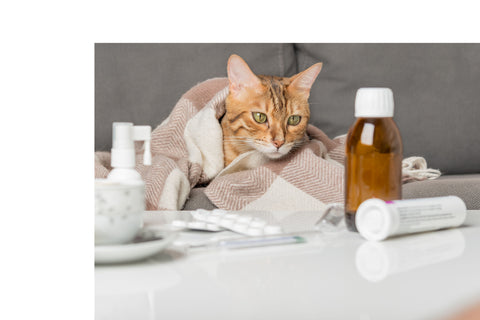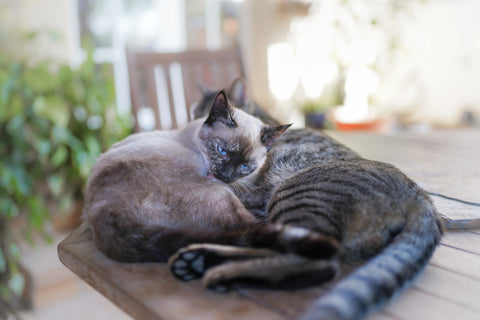
Our main responsibility as the loyal cat guardians is to provide our purrfect companions with lots of love and the very best health care we can get for them. An extremely important aspect of every cat's health is feline dental care.
Unlike us, cats can't brush their own teeth and unlike their wild relatives, they don't chew on bones and grass nearly as sufficiently to naturally maintain their oral hygiene. For these reasons, domestic cats need a little bit of help from us. In light of this, here is our guide through the basics of feline dental care and hygiene.
 Feline dental care
Feline dental care
Why is dental hygiene so important?
In the wild, cats maintain dental hygiene by chewing on bones and grass. In a domestic environment, our pets often can't sufficiently replace this method which makes them highly susceptible to a number of dental and gum diseases. According to Purina, eight out of ten cats over the age of three will experience some kind of tooth or gum problems. Many of these issues are preventable with adequate oral hygiene. This why a routine of teeth cleaning should be established as early as possible.
The cause of most oral health concerns in cats is the accumulation of bacteria, debris and plaque on the outside of their teeth. This bacterial film hardens over time and forms dental tartar, which irritates gums and, if ignored, leads to gingivitis or even loss of teeth.
Gingivitis is a non-destructive inflammation of gums most commonly induced by dental tartar. If left untreated, gingivitis continues to progress and, in some cases, can result in periodontal disease. In periodontal disease, gum inflammation results in tissue destruction, bone resorption, and ultimately, tooth loss. In final stages of the disease, the bacteria from the plaque may reach the bloodstream and cause damage to kidneys and other organs.
 Feline dental care
Feline dental care
How to recognize dental problems in your cat
The most obvious signs of dental problems in cats are bad breath, red and sensitive gums, dental plaque (it is usually yellowish to brown) and excessive drooling. In severe cases of gingivitis, due to pain (caused by irritated gums and loosened teeth), your cat will have trouble chewing and eating, thus losing weight.
Luckily, gingivitis (and other dental problems) are largely preventable, or treatable if diagnosed early. Therefore, make sure to keep an eye for these symptoms and regularly examine your cat's teeth. Consult with a vet as soon as you notice any changes in your cat's teeth in order to prevent the progression of any potential dental diseases.
How to maintain your cat's dental hygiene
Maintaining a cat's dental hygiene can be a lot more challenging than it sounds. The simplest and safest way to prevent dental problems and maintain overall oral hygiene in cats is to regularly brush their teeth. Teeth cleaning will prevent the accumulation of plaque and bacteria, thus preventing (further) formation of tartar. It is usually easier to get the cats used to the teeth cleaning routine early on in life, but adult cats can be trained and adapted to this just as well. Here are a few things to help you get started:

Feline dental care (credits)
1. Start without the toothbrush. In the beginning, you will want to simply get your cat used to you cleaning their teeth. Most cats will not approve of this, but it's important to remember that this is for their own good. Handle your cat gently, and keep the sessions short and positive. It is best not to hold the cat, as you don't want to make them feel unsafe.
Instead, handle your cat when it's relaxed and happy. Then start gently massaging your cat's teeth with your fingers, even if for just a few seconds, whenever you find the opportunity. This way your cat will start getting used to you touching their teeth and they will be more likely to cooperate later on.
2. Introduce the toothpaste. Once your cat is less resentful to you meddling with their teeth, introduce toothpaste. Apply a little bit of toothpaste on your finger and gently clean your cat's teeth.
Please remember NOT to use human toothpaste for your cat. Toothpaste designed for people contains xylitol, a sweetener also commonly found in sugar-free gums and mints. While harmless to us, this substance has been found to be extremely toxic to both cats and dogs. Instead, find a toothpaste specifically designed for cats. These kinds of toothpaste are safe for cats to swallow and you may even find flavored variants (i.e. with chicken), which can be more stimulating for your cat.
3. Introduce the toothbrush. Once your cat has gotten used to the toothpaste, you can finally introduce the toothbrush. Do NOT use human toothbrushes, as they are too rough and unsafe for cats. You can find toothbrushes that are specifically designed for cats which are a much better choice. Try to brush your cat's teeth as often as you can, even if they allow it for very short periods of time. The important thing is that you're doing this and, hopefully, your cat will be more cooperating with time.
4. Look for alternatives. Although brushing teeth is the best thing you can do for your cat's dental health, if you feel that this is insufficient or you simply can't get your cat used to the routine, then you can also find certain alternatives. Dental wipes, water additives, gels and various treats and foods are all commonly available for feline dental care too.
Don't forget, it is highly recommended to schedule regular check-ups with a vet who will monitor your cat's overall health status, including their dental health.
 Feline dental care
Feline dental care
Attention to your pet's dental hygiene is just as important as tending to all their vaccinations, parasite controls, skin and coat care and their overall health status. Help your cat maintain strong, healthy and sparkly teeth and keep them smiling for many years to come.
Further reading:
1. Cat Dental Care by Purina
2. Dental care for Dogs & Cats by World of Animal Welfare
3. Top Ten Tips on How to Keep Your Cat's Teeth Clean by PetMD
4. Home Dental Care Methods for Your Cat by Hill's



